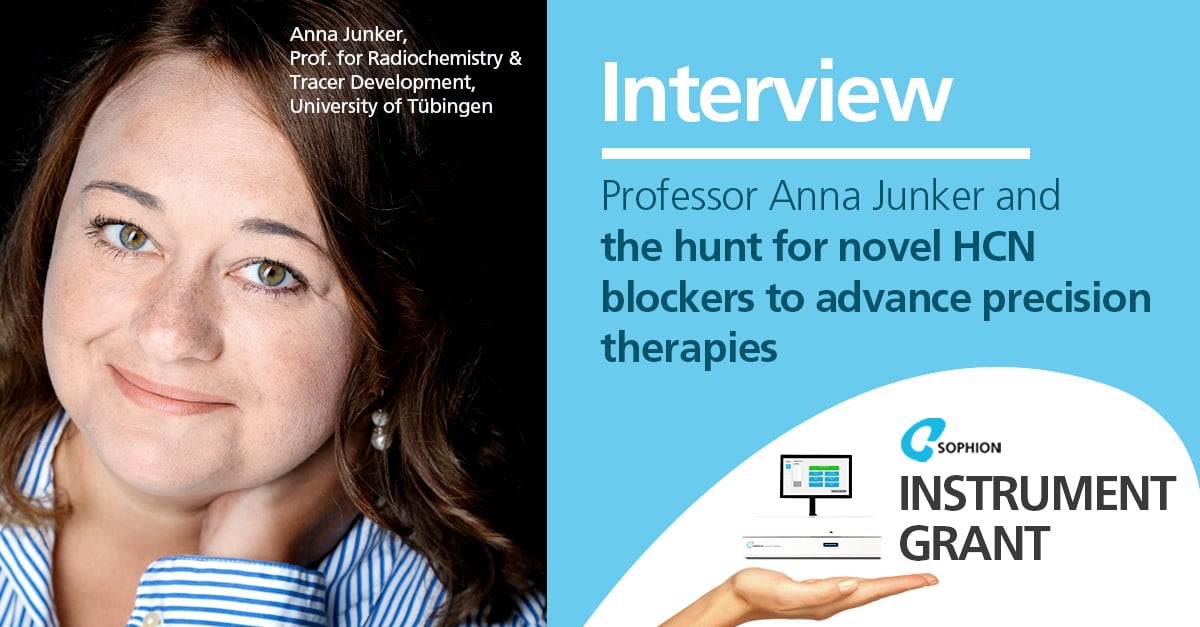
Instrument grant aims for breakthroughs in precision HCN blocker research to advance cardiac and neural therapies
Sophion is excited to announce the awarding of a QPatch Compact instrument grant to Prof. Anna Junker’s lab at the University of Tübingen. This instrument grant will support their groundbreaking research into subtype-selective blockers of hyperpolarization-activated cyclic nucleotide-gated (HCN) channels.
Designing novel allosteric HCN channel antagonists
There are four subtypes of HCN ion channels (HCN1-4), playing pivotal roles in the body, such as regulating cardiac rhythm and neural activity. Despite their importance, selective modulation of individual HCN subtypes remains largely unexplored. Recent cryo-EM advancements have revealed an allosteric binding site in the HCN4 channel, sparking new interest in the development of precise therapeutic agents. Building on these insights, Prof. Junker’s lab is now focused on designing novel allosteric HCN channel antagonists, using zatebradine and EC18 as lead compounds.
Synthesizing potent antagonists to outperform blockers
To this end, Junker’s lab synthesized a library of 60 innovative antagonists and evaluated more than 300 additional compounds from partner CROs. Early screening efforts using manual patch clamp electrophysiological recordings on huHCN1 have already identified several compounds that surpass the inhibitory potency of established blockers, such as zatebradine and ZD7288.
The Sophion instrument grant will facilitate the expansion of these studies by enabling a higher-throughput assay system to screen the entire compound library across all four HCN subtypes. This comprehensive evaluation, including detailed concentration-response analyses, aims to significantly enhance our understanding of HCN channel functionality and accelerate the development of therapies with minimized off-target effects. Sophion hopes the QPatch Compact instrument grant awarded to Prof. Junker will mark an important milestone in advancing precision medicine for cardiac and neurological disorders, with the potential to set a new benchmark in HCN channel research.
Interview with instrument grant winner: Anna Junker
We asked Prof. Junker to share her thoughts on how the instrument grant might help their work in finding novel HCN blockers towards improved HCN targeted therapeutics:
What benefits do you hope it will bring? Personally and/or to your collaborating labs using the shared facility?
We are enthusiastic about the opportunity to incorporate the QPatch Compact instrument into our compound screening and optimization workflows. We aim to address several key questions using this technology, focusing not only on HCN channels—critical targets for our research—but also expanding to additional ion channels such as P2X4R, P2X7R, and NMDA receptors, which we have not yet explored through electrophysiological recordings.
Do you think this will change the perception of automated patch clamp vs manual, conventional patch clamp?
Until now, we have relied on manual, conventional patch clamp techniques through valuable and highly appreciated collaborations with other groups. These partnerships have been instrumental to our progress. However, by increasing our throughput with the QPatch Compact instrument, we see an exciting opportunity to advance our ion channel projects with greater efficiency and, importantly, to develop more independence in this critical area of our research.
"I believe this will definitely change the perception of automated patch clamp compared to the manual conventional method"
What was it like to work with Sophion during this process?
It has been a true pleasure to collaborate with Sophion, a company with real passion for ion channel research. We have greatly valued the opportunity to work with such a dedicated and knowledgeable team, and we look forward to continuing this positive relationship.
In addition to its use in research, have you considered using it as an education tool, to teach/train students in ion channel physiology, pharmacology & the patch clamp technique? E.g. expanding its uses would broaden the justifications with funding bodies, even giving more options for funding sources.
Given the fundamental importance of ion channel research, incorporating hands-on experience with advanced electrophysiological techniques into student education and training would be a valuable addition to their scientific education.
Considering the drug discovery angle of this award, do you see this as a way to collaborate closer with industry and think more commercially?
For the HCN part of the project, we do not have specific collaboration plans at this stage, as the work is still in its preliminary phases. However, for the P2X7 and P2X4 projects, we are planning to engage more closely with industry partners. Many successful drugs have their origins in academic drug discovery programs, and we are always open to exploring new collaborations with industry to help translate our research into therapeutic opportunities.
Would you like to advance your lab’s research with a Sophion Instrument Grant? For more information:
